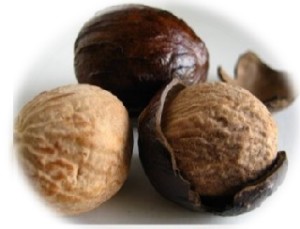Nutmeg
Nutmeg is also known as pala in Indonesia. The most important commercial species is Myristica fragrans, an evergreen tree indigenous to the Banda Islands in the Moluccas or Spice Islands of Indonesia. Nutmeg is the seed of the tree, roughly egg-shaped and about 20 to 30 mm (0.8 to 1.2 in) long and 15 to 18 mm (0.6 to 0.7 in) wide, and weighing between 5 and 10 g (0.2 and 0.4 oz) dried. The first harvest of nutmeg trees takes place 7–9 years after planting, and the trees reach full production after twenty years. Nutmeg is usually used in powdered form.
The Nutmegs are dried gradually in the sun for a period of six to eight weeks. During this time, the Nutmeg shrinks away from its hard seed coat until the kernels rattle in their shells when shaken. The shell is then broken and the Nutmegs are picked up.
Once taken out, they are graded according to the quality viz: ABCD, Shrivelled and broken (BWP). The ABCD quality is further segregated as per their size (calibration) depending on the buyers requirements. Nutmeg contain 7-14% essential oil.

Usage:
It is used to flavor many kinds of baked goods, confections, puddings, meat, sausages, sauces and vegetables. Nutmegs are also used in many savory and sweet dishes. The nutmeg oil is used as condiment and to scent soaps and perfumes. It also has some medicinal properties. Nutmeg is used for flavouring many dishes, usually in ground or grated form, and is best grated fresh in a nutmeg grater. It is used in many sweet, as well as savoury, dishes (predominantly in Mughlai cuisine). It is also added in small quantities as a medicine for infants. It may also be used in small quantities in garam masala. Ground nutmeg is also smoked in India. The essential oil obtained by steam distillation of ground nutmeg is used widely in the perfumery and pharmaceutical industries.
